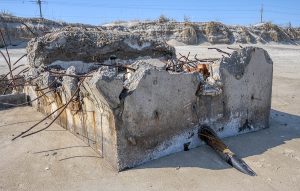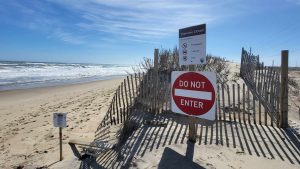Local officials are taking steps to warn the public about Buxton Beach while investigations continue

On the heels of an urgent and emotional resolution passed by the Dare County Board of Commissioners (BOC) and a rising swell of public concern, more than a dozen local, state, and federal officials came together on Wednesday, March 6, to determine the best ways to warn the public about the ongoing safety hazards at Buxton Beach.
The county’s resolution, (which was passed unanimously by the seven-member BOC), was sent to more than 30 state and government representatives who have a connection to the ongoing problems, and who may play a role in future remediation efforts.
Dare County officials are also heading to Washington, D.C. in late March to meet with legislators, with the intention of putting Buxton Beach at the forefront of national attention.
“We – the Vice Chair [Wally Overman], myself, and the County Manager are heading to D.C., and this will be one of our top subject matters when we meet with our legislators,” said Chairman Bob Woodard at Monday’s BOC meeting.
But in the meantime, while remediation investigations are slowly ongoing, plans are being made to warn millions of Cape Hatteras National Seashore visitors about the potential dangers.
The current federal response
The approximately 400-yard stretch of closed shoreline that borders the Buxton Day Use Area has a wide range of issues that fall under the umbrella of several different federal agencies.
When the U.S. Navy and the U.S. Coast Guard used the site, (starting in the 1950s), they did so under a special use permit issued by the Cape Hatteras National Seashore that stated these military branches would leave the shoreline exactly as they found it when they were done using the beachfront area.
The persistent petroleum smells and fuel-infused sediments, along with the abandoned and exposed infrastructure of the former 1956-1982 Naval Facility at Cape Hatteras, fall under the U.S. Army Corps of Engineers Formerly Used Defense Site (FUDS) program, according to stakeholders’ consensus.

In fact, one of the most visible eyesores on the beach – a corner of the Navy’s former Terminal Building, also known as “Building 19” – was already somewhat demolished by the U.S. Army Corps of Engineers in the 1980s.
“Our records show that in the mid-1980s, the Corps put together a plan for removing Building 19 and the [Driftwood Club],” said National Parks of Eastern North Carolina Superintendent, David Hallac, who – along with his colleagues – has spent hundreds of hours on the issue since September 2023.
“But as it appears today, clearly, not all of that building was removed.”
The fuel smells and exposed infrastructure are linked to naval activities. But a corresponding and separate issue of pesticides and PCBs, (which are manmade organic chemicals consisting of carbon, hydrogen, and chlorine atoms), is likely linked to the U.S. Coast Guard, as these problems were present at the site when the Coast Guard left the 50-acre property in 2010.
There is minor movement by both the U.S. Coast Guard and the U.S. Army Corps of Engineers to address these very noticeable issues.
The U.S. Coast Guard is in the middle of conducting a Comprehensive Environmental Response, Compensation, and Liability Act (CERCLA) investigation at the site to evaluate the presence of non-petroleum contaminants. The investigation has been underway for several months and is expected to conclude during the summer of 2024.

Meanwhile, while an earlier investigation to determine a source of petroleum by the U.S. Army Corps of Engineers (USACE) was unsuccessful, the USACE is now conducting an Imminent and Substantial Endangerment (ISE) Determination analysis to hopefully pave the way for actual remediation efforts.
“The Imminent and Substantial Endangerment Determination gives the U.S. Army Corps of Engineers’ FUDS program the ability to move on to the next step, which is the Petroleum, Oil, and Lubricants Decision Document (POL DD),” stated Cheri Pritchard, Media Relations Chief for USACE Savannah District in an email to the Island Free Press on March 7. “The POL DD will detail the proposed remedial action, if warranted.”
“We do not have a timeframe for completing the Imminent and Substantial Endangerment Determination, or the Petroleum, Oil, and Lubricants Decision Document,” she added. “However, we are actively working on completing it, and it is a priority.”
These are solid and optimistic steps in cleaning Buxton Beach, but it is unlikely that current issues will be addressed by the time that waves of summertime visitors arrive.
For that reason, local officials are forced to take a reactive approach in order to inform the public that the shoreline from approximately 46285 Old Lighthouse Road to the first jetty at Old Lighthouse Beach, (and sometimes beyond these boundaries), is not safe.
The local effort to spread the word
“At [Wednesday’s meeting], we had National Park Service staff, county officials, and two individuals from the state Health and Human Services office represented,” said Sheila Davies, Director of Health and Human Services for Dare County. “The last time the majority of stakeholders was on a large call was back in September 2023 when we came together to issue a joint public health advisory release.”
“The fact is that it hasn’t been remedied since then, and we’re heading into the busy visitor season,” said Davies. “And it’s not even staying the same – it’s getting worse.”
“It’s way past time for the remedy to occur… But for now, our focus has to be what [the problem] is, how to protect yourself, and how to report an exposure.”

In that vein, the National Park Service (NPS) and Dare County are joining forces to launch a new and revised public health advisory, which is expected to be released to media outlets and the public within the next several weeks.
In addition, both entities are taking additional steps to ensure that the health hazards of Buxton Beach stay on the public’s radar well into the summer months, as new and potentially unaware visitors land on the Outer Banks every week.
“We’re putting together a video that will come together as a collaboration between the county and our partners to increase awareness and provide information as to what they can do, and [how] to report issues,” said Davies.
The advisory and subsequent videos and/or press releases from the county will include symptoms to be on the lookout for in case of contact with fuel in the ocean, (like a recent incident reported by local surfers in early February 2024.) They will also include contact information for the National Response Center, which is the designated federal point of contact for reporting all oil, chemical, radiological, biological, and etiological discharges into the environment.
The NPS is also creating similar public outreach initiatives to keep residents and visitors informed on the current conditions at Buxton Beach.

In late February, the Cape Hatteras National Seashore launched a new webpage on its site that outlines the history and present conditions of the area, and additional signage will be added to the closed area to help reduce foot traffic.
As of early March, the closed shoreline is constantly inundated with footprints that meander past the current “Do Not Enter” signs near the beach access entrance.
“The big thing is to let people know what the health risks are, and what to do in case of exposure [in terms of] cleaning and taking care of themselves,” said Davies. “If you’re going to that beach, at least you know the risks associated with what you’re doing, and what to do next.”
“We would love to not have to be doing this,” she added. “But in light of the current conditions, it’s necessary.”
For more information
Visitors who encounter a fuel smell or fuel sheens while visiting the Buxton shoreline near Old Lighthouse Road should call the National Response Center at 1-800-424-8802 to report the encounter. Include the date, time, location, and basic details of what was seen or smelled, and do not call if you have not experienced the issue first-hand, or have not been physically affected.
The National Response Center is solely for reporting real-time information on fuel smells or sheens in the Buxton area, as they happen. The Island Free Press will be publishing an article in the near future on how to voice your concerns about the future of Buxton Beach to the agencies and government representatives involved.
In the meantime, the public can learn more about current conditions on Buxton Beach via the Cape Hatteras National Seashore’s webpage, or by reviewing the Island Free Press’ previous reports on the situation.













Plenty of other places to access the beach and ocean. Do not expect this to be resolved anytime soon.